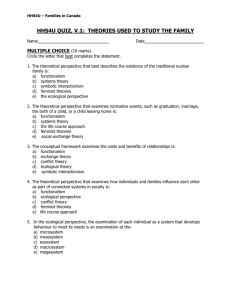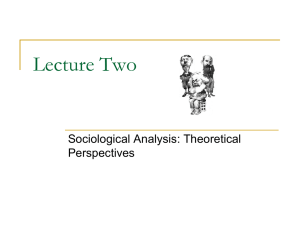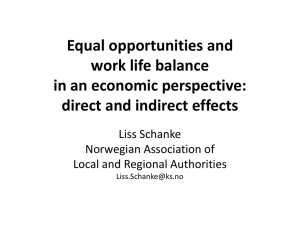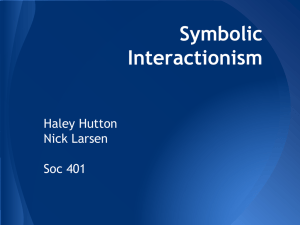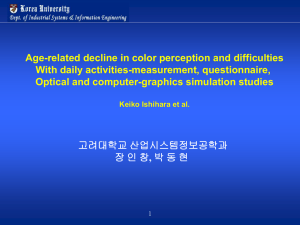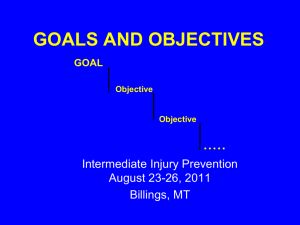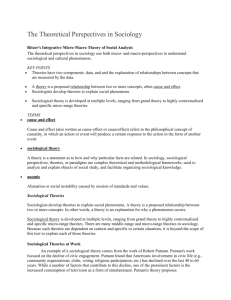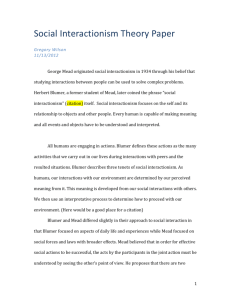Chapter 2 Interpreting Social Problems: Aging
advertisement
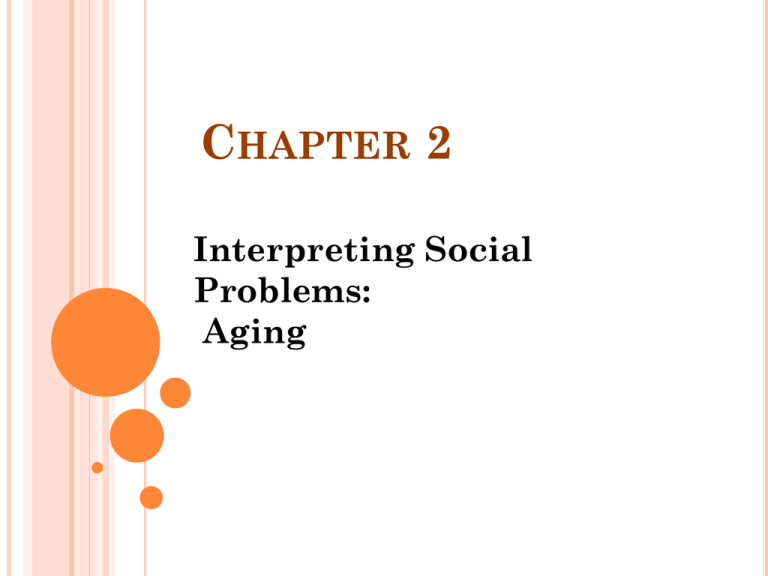
CHAPTER 2 Interpreting Social Problems: Aging SOCIOLOGICAL THEORIES AND SOCIAL PROBLEMS Theory: A statement about how and why specific facts are related. A theory provides a framework for organizing facts, and in so doing, provides a way of interpreting reality. Sociological Theory: Provides a framework for thinking about a social issue from a perspective that we might otherwise neglect; a basic image of society that guides thinking and research. THREE THEORIES FUNCTIONALISM A social system composed of parts that work together to benefit the whole CONFLICT THEORY Groups competing with one another within the same social system; sees society as divided by inequality and conflict SYMBOLIC INTERACTIONISM People’s patterns of behavior always changing; sees society as the product of individuals interacting with one another FUNCTIONALISM AND SOCIAL PROBLEMS Major theory that sociologists use to interpret social problems Sees society as a system with many interrelated parts. When each part does its job, the system runs smoothly. If some part fails, however, the whole machine can suffer (dysfunctions). From the functionalist perspective, a social problem is the failure of some part of society that interferes with the society’s smooth functioning. Problems don’t stem from bad people but bad institutions. THE DEVELOPMENT OF FUNCTIONALISM Auguste Society as organism Herbert Durkheim Normal and abnormal states Robert Spencer Society as structure Emile Comte Merton Functions and dysfunctions APPLYING FUNCTIONALISM PROBLEMS TO SOCIAL Major source of social problems is the inevitable consequence of change. Institutional change in one area of society disrupts the equilibrium of society’s parts, forcing those parts to make new adjustments. Aging: Society needs to pass its positions of responsibility (jobs) from one group (the elderly) to another group (younger people). Disengagement Theory – elderly disengage from society/networks. FUNCTIONALIST THEORY: AGING Functions: Social Security transfers jobs from older workers to younger Social Security not only benefits recipients but families, businesses, and workers at Social Security Administration Nursing homes as positive environments Function of change in family/work patterns Dysfunctions: Nursing home facilities can be inadequate or detrimental Barriers to receiving adequate care and treatment that the elderly face Rules and regulations CONFLICT THEORY AND SOCIAL PROBLEMS Below the surface, society’s parts are competing with one another for scarce resources. From the conflict perspective, social problems are the natural and inevitable outcome of social struggle. Conflict theory: views society as a system in competition and conflict Each group in society attempts to further its own interests, even at the expense of others. As these interests collide, the social order becomes unstable. Those in power exploit people and their resources for their own benefit. THE DEVELOPMENT OF CONFLICT THEORY Karl Marx Capitalism and conflict Bourgeoisie and Proletariat Concluded that the hallmark of history is a struggle for power Georg Simmel Compared the relationships of people who occupy higher positions (superordinates) with those who are in lower positions (subordinates) Lewis Coser Analyzed why conflict is especially likely to develop among people who have close relationships APPLYING CONFLICT THEORY TO SOCIAL PROBLEMS At the root of each social problem lies conflict over the distribution of power and privilege. Social problems are inevitable, for it is inevitable that groups will come in conflict as they try to maintain or to gain control over power and privilege. Those with power don’t like to give it up. Understanding that power and privilege lie at the root of social problems helps analysts to penetrate the surface and pinpoint what any particular social problem is all about. APPLYING CONFLICT THEORY TO SOCIAL PROBLEMS Two types of social problems: Trouble experienced by people who are exploited by the powerful Trouble experienced by the powerful when the exploited resist, rebel, or even appeal to higher values INTRODUCING FEMINIST THEORY Inspired by the Marxist theory and aims to transform society instead of just studying it Patriarchy Rule by men is understood to be the root of all this inequality. To maintain this power, men create boundaries and obstacles for women, making it hard for them to gain power. THE DEVELOPMENT OF FEMINIST THEORY In 1970s, feminist theory was an umbrella term that described oppression of all women. In 1980s, feminists split into five different branches of feminist theory: Radical feminism: dismantle society entirely to dissolve patriarchy Liberal feminism: all people created equal and deserve equal rights Socialist feminism: direct link between capitalist class structure and oppression of women Cultural feminism: biological differences between men and women should be appreciated Ecofeminism: patriarchy oppressive for women and environment APPLYING FEMINIST THEORY TO SOCIAL PROBLEMS Social norms place the burden of care for elderly parents disproportionately on daughters, not sons. In the U.S., men typically do not care for parent(s) because it is often assumed his wages are more vital than a woman’s. Over the next several decades, the population of aged persons will continue to grow, while the number of caregivers remain constant. Social problems are a result of the struggle over resources between men and women. SYMBOLIC INTERACTIONISM AND SOCIAL PROBLEMS The significance of culture Focuses on the symbols that people use to make sense out of life Symbols: things to which we attach meaning and that we use to communicate with one another Because symbols change, so do social problems SYMBOLIC INTERACTIONISM AND SOCIAL PROBLEMS: AGING Earlier in our history, old age was a personal problem, not a social problem. What was once a personal problem has become a social problem From the perspective of symbolic interactionists, then, social problems are whatever people in a society define as social problems. DEVELOPMENT OF SYMBOLIC INTERACTIONISM Georg Simmel (1858–1918) Chicago School Charles Horton Cooley (1864–1929) Looking-glass self George Herbert Mead (1863–1931) Role of the other and generalized other Alfred Schutz (1899–1959), Peter Berger (1929), and Thomas Luckmann (1927–) Phenomenological sociology and social construction of reality APPLYING SYMBOLIC INTERACTIONISM TO SOCIAL PROBLEMS Social Construction of Reality: the attempt to make sense of life by giving meaning to one’s experiences. The Social Construction of Social Problems: Labeling Simply means that people categorize things Put tags on other people or on events and then act accordingly 3 THEORETICAL PERSPECTIVES THE FUTURE OF THE PROBLEM: THE PENDULUM SWINGS Economic growth and expansion of federal programs reduced poverty rate for the aged to below nation’s average Some people think elderly are receiving more than their fair share. Reflects fundamental shift in the subjective concerns of this social problem Belief centers on costs of health care In about 20 years or so, one in five Americans will be elderly. This continuous growth will strain Social Security and health care programs. Figure 2.3 LIFE EXPECTANCY IN GLOBAL PERSPECTIVE THE EMERGING STRUGGLE “Congress has caved in and has given too many benefits to old people.” Some want to trim Social Security, Medicare, and other programs available to the elderly. To protect their gains, older Americans have organized a powerful political lobby. Conflict Perspective The AARP (formerly the American Association of Retired Persons) boasts 38 million members and a staff of 1,200. Difficult for politicians to ignore these numbers Gray Panthers THE EMERGING STRUGGLE The interests of younger and older groups are on a collision course. Two major problems: Contributions to Social Security are not put into a worker’s own account. Proportion that collect Social Security is growing, proportion who are working (those who pay) is shrinking. Dependency ratio: number of workers compared with number of Social Security recipients SOCIAL SECURITY PAYMENTS AND BENEFICIARIES: FEWER WORKERS TO SUPPORT THE RETIRED Problems of Dependency Nursing Homes: Understaffing, Dehumanization, and Death Gender Roles among Elderly Elder Abuse Elderly Poor Gender and the Elderly Gender and Poverty Race-Ethnicity and Poverty RECURRING PROBLEMS: RACE – ETHNICITY AND POVERTY IN OLD AGE Changing Perceptions of the Elderly Ageism Shifting Meanings Technology Influence of Mass Media POLITICS: CONSTRUCTING PROBLEMS AND DEFINING SOLUTIONS The Political Spectrum: a continuum representing a range of political attitudes from “left” to “right” Plays huge role in determining how to solve social problems Each has very different approaches solutions Conservatives: Seek to limit the scope of societal change Liberals: Favor more sweeping change in society Focus on shortcomings of individuals not society See problems in the organization of society Radicals: Support policies that go beyond mere reform Can either be ultra liberal or ultra conservative Who Thinks What? Social forces, structures, location, etc.
